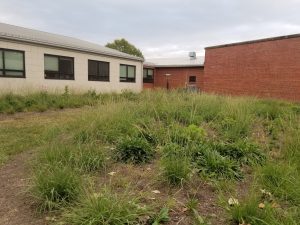Flowers tend to be what people associate with a garden, but the garden outside of Olin doesn’t have many right now. This is because the Olin garden is not a traditional garden. It is much more contemporary. But some don’t seem to understand this. I’ve heard people call the garden “ugly” several times.
As senior biology major Benjamin Nichols explained, “Well, there’s more beauty to [the garden] than just the visual aesthetics. And in the spring, the flowers these will produce will bedazzle them.” The Olin garden is composed of prairie grasses and both native and non-native flowering plants. The plants that are non-native are bred from local genetic lines. As Nichols puts it, “They have been bred to live right here as happy as a plant can be.”
Professor of biology and ecology Dr. Jonathan Micancin is the project’s supervisor and addressed the issues some had with the garden. “That sentiment is one that we expected, and frankly, it demonstrates inexperience on the part of the viewer. The approach to this garden is one that is following some of the most influential landscape designers of the 21st century.”
Micancin is referring to the gardening and landscaping revolution called “The New Perennial” movement. The gardening website, modernlanscapedesigners.com, describes this movement as, “Herbaceous perennials and grasses planted to invoke a naturalistic expression. Forms and organic structures coupled with beauty embracing ecology become intertwined with the concept of ‘Being One’ and with the common sense principle of planting the right plant in the right place.”
“Other gardens like this are major tourist destinations,” explained Micancin. “Establishing any garden from scratch, especially a garden like this with high ornamental value and high value for wildlife, takes time. We are doing really well. Things are going faster than we could have hoped.”
Micancin noted that another perk to having a garden like this is that it really helps Blackburn’s bees and other resident pollinators. “Everybody seems excited by the bees that we keep on campus, and the honey that they are producing. Well, in order to have bees and in order to have honey, we need flowers and that is what our garden provides.”
Students and maybe some staff might not be happy with the way Olin’s garden looks right now, but they should certainly be able to appreciate all the good that it does. Nichols said, “I look forward to seeing it grow and prosper as I come back for homecomings or events after graduation. I hope that the bees and the garden provide future students amazing opportunities in the fields of apiculture, entomology, botany, ecology, behavior (plant, fungal and animal) and much more!”

Olin’s garden actually has a purpose beyond looking good

